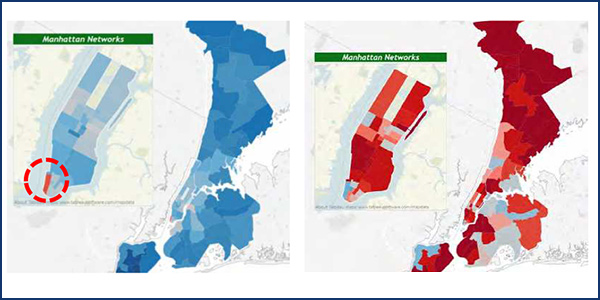FERC ruled Wednesday that New York’s Commercial System Distribution Load Relief Programs (CSRP) are not entitled to an exemption from NYISO’s buyer side mitigation (BSM) because they were designed in part to offset transmission investment (EL16-92-001, et al.).
The ruling by FERC Chair Neil Chatterjee and Commissioner James Danly, both Republicans, sparked a dissent from Democratic Commissioner Richard Glick, who said it was the latest example of the commission’s campaign against state clean energy efforts.
The dispute resulted from a paper hearing initiated by the commission in February, when it narrowed the resources exempt from NYISO’s BSM rules in southeastern New York. Granting a rehearing request by the Independent Power Producers of New York, that ruling partly reversed the commission’s 2017 decision granting a blanket exemption from the rules for special-case resources (SCRs), a type of demand response. (See FERC Narrows NYISO Mitigation Exemptions.)
The commission said the blanket exemption ignored the fact that certain payments made to SCRs outside NYISO’s capacity market could provide the resources with the ability to suppress capacity market prices below competitive levels.
The commission said that SCRs’ offer floors should include only the incremental costs of providing wholesale-level capacity services and that “payments from retail-level demand response programs designed to address distribution-level reliability needs” should be excluded from the calculation of SCRs’ offer floors.
The February order initiated a proceeding to evaluate retail-level DR programs individually to determine whether their payments should be excluded.
Wednesday’s ruling concluded that CSRP should be subject to BSM but that payments received under the Distribution Load Relief Programs (DLRP) qualify for exclusion from the calculation of offer floors.
Under Con Edison’s DLRP, customers receive notification two hours before a DLRP event, which is called to address an isolated need. In contrast, the utility’s customers receive notification at least 21 hours before a CSRP event, which is called in response to system-wide peak demand.
“The record in this proceeding demonstrates that the purpose of the DLRPs under consideration is to maintain distribution-level reliability by reducing distribution system demands in response to contingencies and other emergencies,” the commission said.
“We find, however, that the CSRPs under consideration are not designed to address and do not address solely distribution-level reliability needs, and therefore payments received under those programs must be included in the calculation of SCR offer floors in NYISO. … Both Con Edison and Orange and Rockland state that the CSRPs under consideration provide network load relief to the system during peak hours to address system-wide needs under peak load operating conditions.”
The commission said its case-by-case review of DR programs ensures a balance between the need to protect NYISO’s capacity markets while avoiding inappropriate barriers to DR’s participation in the market.
Glick disagreed, saying the order “once again perverts buyer-side market power mitigation into a series of unnecessary and unreasoned obstacles to New York’s efforts to shape the resource mix.”
“Buyer-side market power rules — often referred to as minimum offer price rules or MOPRs — that were once intended only as a means of preventing the exercise of market power have evolved into a scheme for propping up prices, freezing in place the current resource mix, and blocking states’ exercise of their authority over resource decision making,” Glick wrote.
Glick said the majority made “arbitrary distinctions” between different types of retail-level demand response programs.
“The record before us suggests that both DLRPs and CSRPs are retail-level programs directed at distribution system issues. They do so by having retail customers curtail their consumption in order to reduce the stress on particular elements of the distribution system,” he said. “That solves a very different issue than NYISO’s SCR program, which addresses peak demand on and the reliability of the bulk power system by, among other things, calling on demand response to maintain adequate operating reserves. To see that, one need look no further than the fact that the dispatch of DLRPs and CSRPs rarely overlaps NYISO’s SCR dispatch.”




